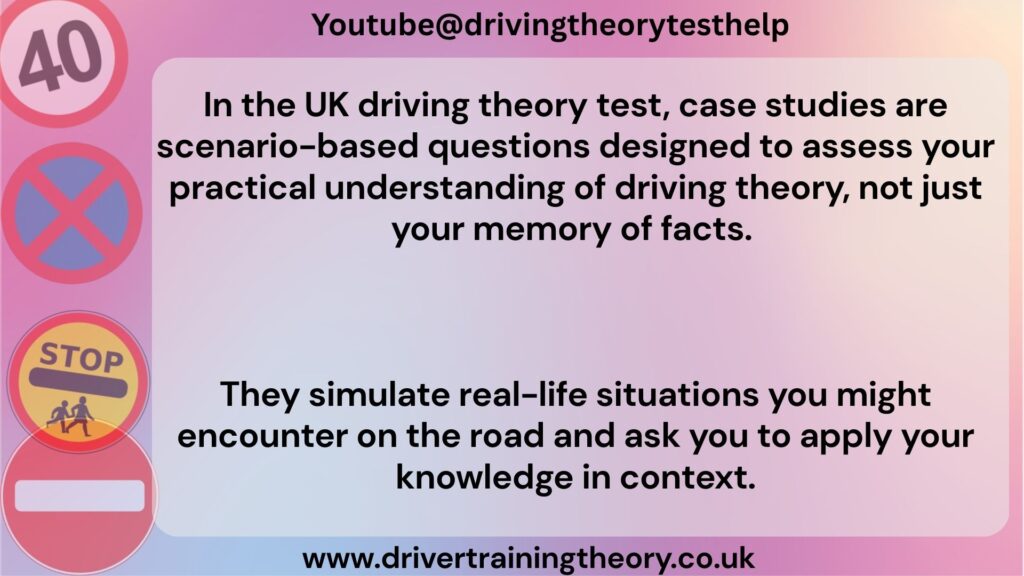Theory Test Case Studies Explained: In the UK driving theory test, case studies are scenario-based questions designed to assess your practical understanding of driving theory, not just your memory of facts. They simulate real-life situations you might encounter on the road and ask you to apply your knowledge in context. For instance, you might find yourself facing a scenario that involves navigating through a busy city center during rush hour, which requires you to consider traffic patterns, pedestrian behavior, and road signs. Understanding these scenarios fully allows you to prepare for challenges you may face on the road, such as unexpected obstacles or changes in traffic flow.
Theory Test Case Studies Explained
Understanding these case studies is pivotal for new drivers. They prepare you not only for the theory test but also for real-world driving situations. By practicing with these case studies, learners can enhance their decision-making skills, which are crucial for safe driving. For example, recognizing the right course of action when faced with a pedestrian suddenly stepping onto the road can prevent accidents and save lives. Such practice reinforces the importance of being vigilant and responsive to changing circumstances while driving.

Moreover, engaging with these case studies not only sharpens your skills but also boosts your confidence as you prepare for your driving test. You start to learn that driving isn’t just about operating a vehicle, but also about making informed choices that prioritize safety for yourself and others.
Theory Test Case Studies Explained
Additionally, these case studies often incorporate varied scenarios, such as dealing with adverse weather conditions like rain or snow, which affect visibility and road traction. By considering how these factors influence driving decisions, learners are better equipped to handle similar situations in reality. For instance, if you’re informed about the risks of hydroplaning on wet roads, you may drive more cautiously and maintain a safe following distance.
In addition to the main story provided, each question is crafted to evaluate a specific aspect of driving, ensuring that learners must demonstrate a comprehensive understanding of driving principles.
Theory Test Case Studies Explained How They Work:
Case studies are structured to reflect realistic driving environments and challenges. You’ll encounter various components that test your knowledge thoroughly.
- You’re given a short story or scenario, usually about a journey or driving situation.
Example: “You are planning a long motorway journey on a hot summer’s day. You’re taking your elderly grandmother and her dog with you…” - You then answer 5 multiple-choice questions based on that scenario.
- The questions may cover topics like:
- Hazard perception and risk (e.g., tiredness on long journeys)
- Vehicle checks and preparation
- Rules of the road
- Environmental considerations
- Driver attitude and responsibilities
Theory Test Case Studies Explained Why They Matter:
Case studies test whether you can think like a driver — not just what the rules are, but how and when to apply them. The DVSA introduced them to reflect real-world decision-making, encouraging learner drivers to engage more deeply with safe, responsible driving. For instance, understanding the implications of traffic signals and signs in different scenarios can help prevent accidents. This deeper understanding can lead to better anticipation of potential hazards and a proactive approach to driving.
Case studies test whether you can think like a driver — not just what the rules are, but how and when to apply them. The DVSA introduced them to reflect real-world decision-making, encouraging learner drivers to engage more deeply with safe, responsible driving. For instance, understanding the implications of traffic signals and signs in different scenarios can help prevent accidents.
Theory Test Case Studies Explained Tips for Success:
Don’t rush them. Read the whole scenario carefully before answering. Think about what you would do in that situation, based on the Highway Code, your training, and common sense. It’s also beneficial to visualize the scenario, considering how different decisions can lead to various outcomes on the road. For example, if you visualize arriving at a roundabout, consider how your choice to yield or proceed could impact not only your safety but also that of others.
Additionally, by immersing oneself in these case studies, learners can develop a more intuitive grasp of safe driving practices, recognizing that driving is not merely about following regulations but also about adapting to the dynamic nature of the road. Practical examples of this adaptability include adjusting your speed for changing weather conditions or being prepared to stop for unexpected pedestrians.
Theory Test Case Studies Explained
Overall, engaging with case studies helps you build a repertoire of strategies to handle various driving situations, enhancing both your theoretical knowledge and practical skills.
It’s also helpful to discuss these scenarios with a mentor or instructor, as they can provide valuable insights and share experiences that deepen your understanding. Engaging in discussions about hypothetical situations can uncover different perspectives on decision-making.
Finally, practicing with sample case studies can build your confidence and familiarity with this format, making you better prepared for the actual test. This preparation not only enhances your theoretical knowledge but also reinforces the habits necessary for safe driving.
Furthermore, as you navigate these case studies, you gain insight into the psychological aspects of driving, including how stress and fatigue can affect your decision-making. Recognizing the signs of fatigue, for example, ensures you prioritize safety over reaching your destination quickly.
Additionally, by immersing oneself in these case studies, learners can develop a more intuitive grasp of safe driving practices, recognizing that driving is not merely about following regulations but also about adapting to the dynamic nature of the road.
Finally, practicing with sample case studies can build your confidence and familiarity with this format, making you better prepared for the actual test.